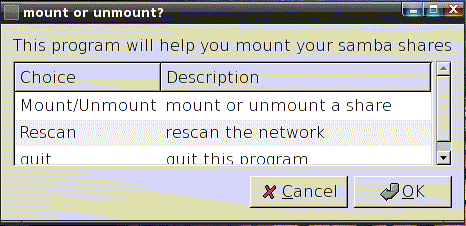
Vector Linux 5.9
 |
Vector Linux 5.9 Documentation |
VectorLinux v5.9 Special System Utilities and Tools |
CONTENTS1. VasmCC 2. vpackager 3. vcpufreq 4. vleasytables 5. vl-hot-config 6. vlsmbmount 7. vwifi 8. wifi-radar VectorLinux v5.9 provides users with a number of new system tools to make administration of their computer system easier than hand-editing configuration files. These utilities are described in detail below, but for the most part, their usage is trivial and obvious. Where that is not the case the intracacies are explained. 1. VasmCCVasmCC is the VectorLinux Control Centre. It provides an iconic GUI interface to vasm, and is modelled upon Suse Linux's YAST software. VASM is the Vector Administration and System Menu, fully explained in the VASM manual. VASM itself is an ncurses based text menu interface, which may appear archaic to some, but is fully functional nonetheless. VasmCC is simply a GUI wrapper to vasm. It is still under development as at February 1st, 2008. There is presently more functionality to the system adminstrator by using vasm rather than VasmCC. The images below show the basic functionality of this sofware.
2. vpackagervpackager is VectorLinux's new utility which enables users to build a properly packaged VL .tlz package from source code. A complete explanation of the VL package management system (gslapt and slapt-get) is found in our slapt-get/gslapt/packages manual. The user is also referred to our forum where a full explanation on how to build a package is described.vpackager documentation is fully explained at the vpackager website, so will not be fully re-iterated here. Newer Linux users should be aware that vpackager is not required to install or remove packages. Such functionality is provided instead by "gslapt". The image below shows the basic functionality of vpackager. 
3. vcpufreq"vcpufreq" is a Central Processing Unit (CPU) frequency configuration utility developed in Gambas by Joe1962 for VectorLinux. It makes it easy to change the CPU frequency governor (with those CPU's which have such a function) and related frequency settings. It does not (yet) load the appropriate cpufreq module for your system. vcpufreq includes the CLI utility "vcpufreq-load" to set the saved configuration on system start. This utility requires root access and requires that the appropriate module is loaded. With most modern CPU's this will be done at boot up. If this is not the case then the user must find out which module is relevant and works with their CPU and then use the command "modprobe name_of_module" in their /etc/rc.d/rc.local file, to ensure the module is loaded at boot time. A listing of the available CPU modules are found in the directory /usr/src/linux-2.6.22.14/arch/i386/kernel/cpu/cpufreq. vcpufreq would be useful to those with notebook computers in order to reduce CPU frequency (and hence battery usage). The image below shows the basic functionality of vcpufreq.
4. vleasytables"vleasytables" is a simple, unique, menu driven utility which enables a user to rapidly build their own custom firewall. It is basically a front end to the Linux software utility "iptables" and therefore requires root access. The utility enables one to also start and stop the firewall and have the firewall loaded on every boot. This utility should only be used with those having a reasonably good knowledge of firewalls and iptables. The image below shows the basic functionality of vleasytables.
5. vl-hot-config"vl-hot-config" provides simple configuration to the VectorLinux automounting system called vl-hot. vl-hot is a purely udev based automount system for any kind of pluggable storage device that conforms to the block device specification (and so it uses scsi emulation). It was officially included in Vector Linux 5.1 SOHO and subsequent releases. Hardware known to work with vl-hot are USB pendrives, hard disks, digital cameras, memory card readers, PCCARD (or PCMCIA) memory cards and external USB drives. Firewire devices should work, but there are no user reports on this kind of hardware yet. More information on vl-hot and its differences to the HAL autmount system are found in the VL mounting manual and the VL external devices manual. The working specifications of vl-hot are such that the mount base directory will be "/mnt/vl-hot/", each drive will have a "sd?" directory (where "?" represents a letter of the alphabet) and each mounted partition will have a "vol#" directory (where "#" represents a number) within the drive directory. An exception to this rule is in the case of non-MBR devices, where there is no partition table. Desktop icons are dynamically created/deleted (currently only for KDE and xfce) and these have an unmount options in the context (right-click) menu. There is a conventional unmount (should be used normally) as well as options for unmount with signalling to the process that is holding open the mount and unmount with killing of said process (the last two should be tried in that order, when the normal unmount fails). The unmount operation has completed succesfully once the desktop icon disappears. vl-hot-config enables the user to change the base mount directory, the mount icon, what should be included and automatically excluded from the mount process, the log file locations, sound notifications and mount specifics depending on filesystem type. The image below shows the basic functionality of vl-hot-config.
6. vlsmbmount"vlsmbmount" is simply a front end menu message to the xsmb.sh shell script, which assists a user in connecting their computers via Samba. For this system to work the user must have the smbd and nmbd service daemons running beforehand. To do so go to System, VASM, SUPER, SERVICE, SRVSET, 4 and enable the Samba daemon. The images below shows the basic functionality of vlsmbmount.
7. vwifi"vwifi" is a relatively simple bash script which attempts to detect the user's wireless card device and to launch the wifi services via the iwconfig, dhcpcd and ifconfig network commands. If it does not find an appropriate module for your device it will ask you for an appropriate one from a supplied list. The user should know what module to choose. To know this the user must determine his/her chipset within the wireless device (use "lspci") and then visit this Linux wireless site. Any further questions regarding problems about VL and wireless might be solved by reading our wireless HOWTO. 8. wifi-radar"wifi-radar" enables you to scan for available networks and create profiles for your preferred networks. At boot time, running WiFi Radar will automatically scan for an available preferred network and connect to it. You can drag and drop your preferred networks to arrange the profile priority. For further information visit the wifi-radar website. The image below shows the basic functionality of wifi-radar.
9. CreditsCopyright 2008 Vector Linux Text by various VectorLinux developers and lagagnon, 2008. |